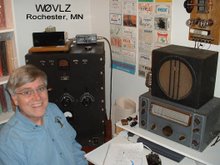I downloaded DigiPan from http://www.digipan.net/ (Freeware) onto my laptop, not for the PSK31 function but for the waterfall. I then configured DigiPan to use my laptop built-in mic as the audio input/source. With my laptop sitting next to my KX3 I tuned to a unpopulated but white noisy frequency. This may require the preamp to be turned on. While watching the white noise on the DigiPan waterfall I tweaked the various filter settings. The white noise waterfall display changes to reflect the filter settings, clearly showing me the impact of what I was doing. SSB, CW and data signals can even be tuned in and viewed as the various selectivity options are changed. The KX3 CWT Aid and the Filter Passband Graphic show some of this but not to the detail of the DigiPan waterfall.
 For example here's a sample waterfall showing the impact of narrowing the KX3 bandwidth setting followed by adding the Audio Peak Filter (APF). The horizontal scale is frequency (in Hz) and time is the vertical scale. The CW signal of interest is the yellow streak at 520Hz. Interference is the yellow (stronger) and blue (weaker) around the 520Hz signal.
For example here's a sample waterfall showing the impact of narrowing the KX3 bandwidth setting followed by adding the Audio Peak Filter (APF). The horizontal scale is frequency (in Hz) and time is the vertical scale. The CW signal of interest is the yellow streak at 520Hz. Interference is the yellow (stronger) and blue (weaker) around the 520Hz signal.


















